The photographs of John Brosnan, S.J. in DigitalGeorgetown contain four photographs with the title “Woodstock College - Stamp Crucifix”. These black-and-white photos, digitized from the original glass plate negatives, show a mosaic-style rendering of Christ on the cross made entirely from postage stamps, with enough detail to show individual stamps and postmarks. However, much of the design is difficult to discern because of the minimal contrast between stamp colors in the black-and-white photographic rendering. Perhaps anticipating this issue, one of Brosnan’s photographs is labeled as a “Color Blind Plate,” likely taken with a blue filter in an effort to increase the visibility of the design, although the result still leaves the central figure unclear.
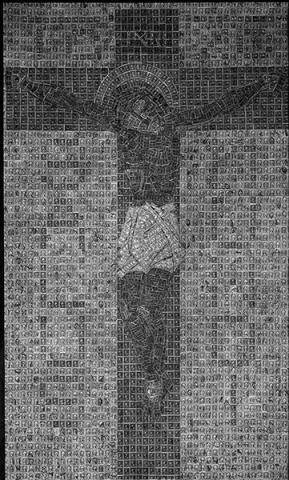

Two of the black-and-white photographs from the Brosnan Photograph collection depicting the postage stamp crucifix; the second image is the “Color Blind Plate”
The large negatives preserve a tremendous amount of detail and zooming in shows that the stamps used to construct the mosaic were common American stamps from the 1920s and 1930s, providing a limited color palette that permits accurate colorization of the photographs.

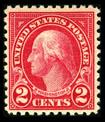

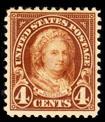
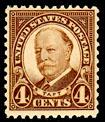


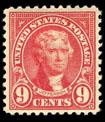
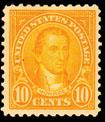
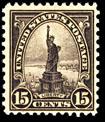
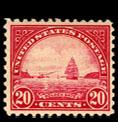
The entire mosaic is composed of these eleven American stamps issued between 1922 and 1932.
Additionally, the uniform size of the stamps combined with their number in each dimension indicates that the mosaic was quite large, approximately six feet tall and about four feet wide. Close inspection reveals other details: of the few visible and legible postmarks none were dated past 1937, and very few stamps were trimmed or cut. Instead, the design was built up with multiple layers of overlapping stamps.
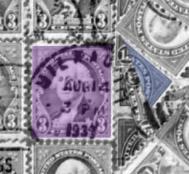
Detail from the area just to the left of the loin cloth, showing a stamp with a postmark dated August 14, 1937 (in purple) near one of just two trimmed stamps in the mosaic (in blue)
Colorization was completed in Photoshop from the highest-resolution scan available, with each stamp colored individually to accurately capture the detail of the mosaic. The cross itself is green, the background purple with red lettering, the body of Christ yellow with shades of orange and brown, and his loincloth blue. The nails in his hands and feet are grey while the blood is depicted in various shades of red.
While colorization provided a greater visual sense of the original mosaic, it also prompted further questions. Where did the crucifix come from? Who was the artist? And where is it now? Research in the Woodstock Archives, philatelic literature, and inquiries within the Jesuit community have solved these mysteries as well.

The completed colorized version of the Woodstock postage stamp crucifix, clearly showing the Christogram IC XC above the cross and Latin inscription SALUS MUNDI (Salvation of the World) along the sides. (High resolution version)
In 1931 Woodstock College, located in rural Maryland, organized an enterprise to collect stamp donations from contributors around the world, modeled on similar programs at other Catholic schools. Stamps were sorted by Woodstock students, with common stamps being sold by the pound and rarer stamps being sold directly to collectors or dealers. Known as the Mission Stamp Exchange, the initiative generated thousands of dollars for the Jesuit missions, much of which was sent to the Philippines. By 1938 the Mission Stamp Exchange occupied five rooms at Woodstock and over 100 of the Theologians and Philosophers were occupied with the sorting and processing of donations during their recreation time. The enterprise continued for decades and served as both a fundraising activity, and as a way to connect American religious and lay persons to Catholic communities and their needs thousands of miles away.
It was against this backdrop that Anthony G. Schirmann, S.J. assembled his mosaic from 4,324 postage stamps, working three hours a week for 16 months. While cancellations on the stamps are clearly visible across much of the mosaic, Schirmann minimized the visible cancellations on the body of Christ through careful overlapping. The mosaic’s design is based on the twelfth station from a set of stations of the cross designed by Elsa Schmid, which itself drew inspiration from a mosaic of the crucifixion at the monastery in Daphni, Greece. Schirmann was ordained at Woodstock in 1937, which is presumably why none of the stamps show signs of use past that year. After leaving Woodstock, Schirmann went on to parish and mission work in Philadelphia, Southern Maryland, and Buffalo. He died in 1971 in Amsterdam, New York.
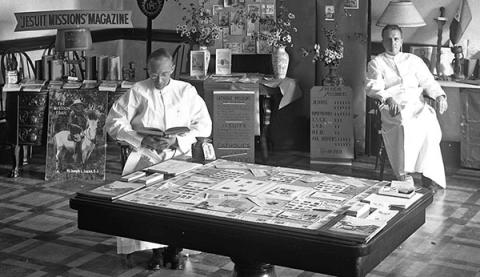
A photograph of a mission exhibit at Woodstock in 1939 from the Brosnan collection. The center of the room features a table covered in stamps and philatelic objects.
The stamp mosaic was kept at Woodstock College but made occasional appearances at philatelic conferences and events where Jesuits would promote the Stamp Mission to dealers and collectors. It also was featured in a color photograph in a 1954 National Geographic Magazine article featuring stamp collecting and the postal service. With the closing of Woodstock College, the mosaic was transferred to the Jesuit Novitiate in Wernersville, Pennsylvania, which closed in 2021. It now resides at the Frances M. Maguire Art Museum at Saint Joseph's University.
Acknowledgements
Written and researched by Steve Fernie and Adrian Vaagenes.
Colorization by Steve Fernie.
Special thanks to Aleksandra Kinlen, Ted Mallison, Marjan Moaddel, and Natalia Porras.
Postage stamp images courtesy of Wikimedia Commons.
Sources
“The Mission Stamp Exchange”, The Woodstock Letters, Vol. LXVII No. 1, 1938, pp.82-86.
“Stamp Collecting and the Foreign Missions”, Francis X. Finegan, S.J., The Woodstock Letters, Vol. XLVII No. 1, 1918, pp.26-35.
"Stamp Collecting for Foreign Missions", Georgetown College Journal, Vol. LXI No. 7, May 1933, pp.551-552
“Ordinations for 1937”, The Woodstock Letters, Vol. LXVI No. 3, 1937, p.441.
“Stamps to Save Souls”, Edith M. Fisher, Philippine Journal of Philately, Vol. III No. 1, 1950, pp.32-34.
“Everyone’s Servant, the Post Office”, Allan C. Fisher, National Geographic Magazine, July, 1954, pp.121-152. Photo of the Woodstock crucifix appears on p.130.
"A Modern Way of the Cross in Mosaic", Hildreth Meiere, Liturgical Arts, Vol. I No. 1, Fall 1931, pp.34-37
“Fr. Anthony Schirmann Dies; Served in Buffalo”, Buffalo Courier-Express, July 20, 1971, p.16
